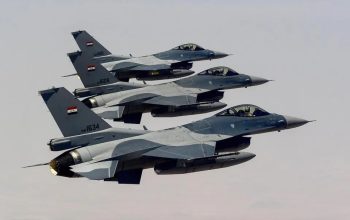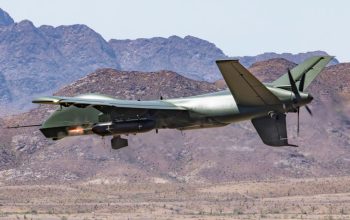Lockheed Martin has developed a new version of the Joint Air-to-Ground Missile (JAGM) that doubles its current range, and it proved the capability in a recent flight test. The company also incorporated a tri-mode seeker that pairs a low-cost imaging sensor with the seeker’s semi-active laser and millimeter wave sensors. The U.S. Army originally required the JAGM weapon to have a tri-mode seeker, but the service walked back to a dual-mode seeker requirement during a competitive development stage. The new missile, which Lockheed is calling the JAGM-Medium Range, or JAGM-MR, traveled 16 kilometers (9.94 miles) in a flight test on Nov. 16 at Naval Air Weapons Station China Lake, California.
The Army and the Marine Corps declared JAGM ready for full-rate production at the end of August 2022. The decision was delayed after the weapon previously failed to achieve desired lethal effects on a maritime target, resulting in the Army and the Marine Corps delaying the missile’s fielding by more than a year. Cost was a factor for the Army when choosing to back of the tri-mode seeker requirement, but since then the price of tri-mode seeker technology has become more affordable. JAGM will replace Lockheed-made Hellfire missiles aboard American aircraft and will first be fielded on AH-64E Apache attack helicopters and Marine Corps AH-1Z Viper helicopters.

The longer-range capability is critical for the military’s desire to achieve greater standoff from enemy locations — to operate out of range of enemy weapons systems. The Army has repeatedly stated its need for longer-range munitions across the board, but particularly for its helicopter fleet. It is also pursuing a long-range precision munition in a separate competitive effort and is currently using Israeli company Rafael Advanced Defense Systems’ Spike Non-Line-of-Sight missiles in the interim. There’s been quite a bit of activity and interest in this new capability with customers international and domestic.
Lockheed invested in the upgrades with no external investment, but would not say how much funding it put toward the effort. While the Army and the Marine Corps are the first adopters of the capability, the United Kingdom also signed on to receive JAGM, committing to the new missile in 2021.Lockheed plans to continue proving out the technology both on the tri-mode seeker and range fronts over 2023. The Army is now looking to address its aviation strategy with a JAGM Increment 3 requirement, which would increase the range of the missile and add the tri-mode seeker. The company stated it is now working with the Army to develop the JAGM roadmap to go from development to production as quickly as possible.














